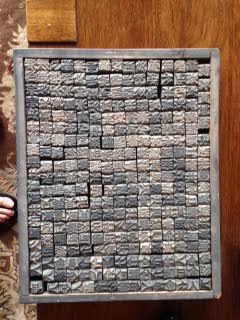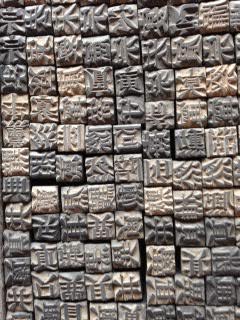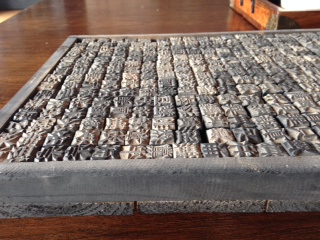Chinese type
Hi-
Is anyone familiar with Chinese type? I bought these at a antique show and was told they are around 300 years old. I am interested in them as art more than anything, but just curious if anyone had any history for me or a resource. Thank you.

type1.jpg

type2.jpg

type3.jpg
I would be EXTREMELY skeptical of the 300 year “age” of your type. From what little I remember, this stuff was still being cast into the 1970’s and 1980’s and perhaps even into the 1990’s (and may still be made today????). I think there was a place in Seattle that cast it for the West Coast Chinese newspaper communities (San Francisco, etc.). I believe that there are several hundred different characters that make up a complete font. They are basically word glyphs. The Chinese newspapers in San Francisco’s Chinatown would have rooms full of very large slanted cases and the compositors would walk around picking out the characters that they needed.
The Monotype casters that pumped out this type were fairly busy replacing the worn characters. Note that they are all on the same square body to make composition easier.
Rick
You may be interested in this
http://www.taiwantoday.tw/ct.asp?xItem=141023&CtNode=430
I have a modest amount of Gujarati font but, not understanding the language, am afraid to use it in case I offend someone. Fascinating stuff though.
>> I believe that there are several hundred different
>>characters that make up a complete font.
“complete” is of course a misnomer when it comes to Chinese as there are tens of thousands of different characters. Indeed you can invent your own characters - brands often do.
Hi-
I have 4 trays total of this font and it is all wood - no metal. I have no idea how old it is and bought it from someone who brought it out of China in a suitcase.
Thanks for your insight.
Talia
This is a link to a site that shows you the type cabinets that were in use at Augustin printers in the north of Germany. The typesetter would stand in the middle of the circle and have access to all the 8600 characters available.
http://gefischtes.de/portfolio/
Which just goes to show why, when the Chinese invented moveable type in the 11th century, they quickly abandoned it as useless. It’s not a technique that’s exactly well-suited to the Chinese language.
—
Michael Hurley
Titivilus Press
Memphis, TN
Earlier solutions were apparently similar to this museum recreation:
http://www.nauvootimes.com/columns/jeff-lindsay/2013-01-25-d.jpg
memphits, What makes you think it was abandoned? There is still a traditional letterpress shop in Vancouver’s Chinatown, and I’ll bet there are quite a few in China as well.
http://vancouver-chinatown.com/gallery/gallery.php?p=2&i=11
Mephits, nothing has been abandoned, typesetting continues: http://blog.typoretum.co.uk/2012/05/02/preserving-traditional-chinese-printing-–-mr-chang/
The shop in Vancouver was shut down and gradually parted out over the last two years or so. They had a final fire sale a few months back, and now they are just an entry in the history books.
Sorry to hear that. Needless to say, it wasn’t quickly abandoned.
the museum of printing in North Andover, MA has quite a collection of Chinese type, they have some of it on display.
I presume they have no serifs/sans/styles to tangle with (different point sizes? maybe a bold?) but with 8600 characters that’s handling around 100 cases at once.
Very impressive
It’s not 8,600 characters. There are probably over 100,000 different characters in existence, though most dictionaries are likely to have fewer than half that.
If you want to read a newspaper you need to learn 2000-3000 of them, and they say that an educated Chinaman will know maybe 8,000.
But yes, moveable type didn’t really help the Chinese terribly much!
The technique of individual type tiles as originally invented in the 11th didn’t catch on and was never in widespread use, as far as I know. Due to the complex nature of the written language it was as easy to carve entire pages as woodblocks rather than trying to set individual ideogram types. There was continued experimentation into the use of wood, metal and ceramic for sorts of type, but none of them saw widespread usage in general printing. The only things that seem to have regularly used moveable types of any kind were things like financial documents that needed to be regularly changed to reduce counterfeiting. There were also a few very large-run books set in moveable type, but this was unusual enough to elicit comment in the history books.
So, I suppose saying it was abandoned was overly harsh of me but the fact remains that it was not the dominant method of printing in the East until much, much later. The metal types being discussed above are, I’m sure, no earlier in production date than the mid-19th century. For one thing, the type used in that shop in Vancouver or in the gorgeous cases Mr. Gravemaker posted were clearly made to work in European-style printing presses which weren’t introduced into East Asia until the latter half of the 19th century. Earlier Asian type sorts were flat tiles. The woodtype the original poster has looks to be of this style, though I can’t tell for sure.
All of this is to say that I find it unlikely that the type the original poster showed is 300 years old (though it’s not impossible). It may well be 150 years old, though. And that’s not to say it isn’t fascinating and beautiful and worthy of a place in any fine type collection. I just doubt it’s quite as old as the seller intimated. One way to check would be to see if there are any archaic ideogram forms in the sorts and then see when those forms may have been abandoned.
—
Michael Hurley
Titivilus Press
Memphis, TN
Three hundred years old isn’t such a stretch — the first press in the American colonies was established just short of 400 years ago.
Bob
The American colonies aren’t in East Asia and the existence of European-style printing in European colonies is hardly a surprise. What does this have to do with printing in ancient and modern China?
—
Michael Hurley
Titivilus Press
Memphis, TN
Duplicate post. My apologies.
—
Michael Hurley
Titivilus Press
Memphis, TN
I’m not an expert on Chinese movable type, but I did spend many months studying the hand-carved block printing techniques used in Tibet. The printers there were all unanimous in their opinion that oriental texts are too complex to lend themselves well to movable type. In fact, they laughed at how simple and primitive English was…. “Only 26 letters! Dang, you must not have very complex thoughts! ”
I too doubt the 300 yr old claim for that particular font, since I saw many, many boxes similar to that one back in the 1960’s in San Francisco. It is still cool, however…. and if you can read it, it would make a nice addition to one’s catalog for printing oriental themed items.
First, the type being discussed is made from wood, second the Chinese invention while time consuming was used in some form for almost a thousand years. The invention of moveable type was originally types made of wood, but it was later adapted to ceramic types. It’s not like it was invented and then forgotten as has been argued above. It apparently was an expensive process in the beginning, which limited its use, but it did continue to be used in China and Korea. Much later when western printing machines were introduced, they too were adapted to use in China and later when it was opened to foreigners, Japan. The type is probably 75 to 100 years old, but since I cannot examine it for saw marks, &c. it is only a guess. It’s condition is such that it looks like it was little used, and probably dates to the end of the common-use letterpress era, rather than being abandoned because it was no longer usable.
An average college educated Chinese handles up to 8000 characters, higher educated around 12-15 k,
Classical scholars like my Brother in Law commanders 28 -30 k characters and is renowned for it.
Type was sandcastle ford the use of imported casting machinery, skill comes in which is hard to fathom to western people than you see how fast they can cut in wood. As I had already pointed out in a private email, while quaint, these are not rare or too old
Many a country shop had a line or two of Chinese type lolling in the sorts case. Came in handy for block-out. For the kiddies, those were the days when, instead of throwing out reams of letter or billhead simply because of a number change, the offending line was artfully printed over and the new info laid down. Border slide slugs were used also of course, but nothing could match the coverup of Chinese typeface. :o)
Is there a foundry where I can order some of this?
I don’t know of anyone in the US casting it. Monotype made matrix for Chinese characters, so it’s possible you might find a foundry in Hong Kong that is still running. As I understand it monotype machines from that side of the world have a different depth of drive, so I’m not even sure if someone in the US had matrix they could cast it.
Anyone interested in early type ought to have a look into the Phaistos Disk, from Cyprus, thought to be about 1700 BC, if its genuine then its quite remarkable. And an anecdote quite off topic, when Crete was liberated in Ww2, a senior RAF officer went to see Knossos. Re-opened specially for him,
the important guests book was brought out for him to sign,
the immediately preceeding signature was that of one H. Himmler!
The ‘Stichting Lettergieten Westzaan 1983’ in the town of Westzaan in the Netherlands is actually in the process of casting Chinese characters on their Monotype machines right now. Some 8,000 matrices that once were used at the Amsterdam Typefoundry have re-surfaced and are being cast. Contact Mr. Ronald Steur, the chairman of the foundation for more information.
http://www.lettergieten.nl
and
https://www.facebook.com/ronald.steur.7
And this: https://www.facebook.com/ronald.steur.7/videos/pcb.10217368033937418/102...
I also found this, a 1970s newsreel from the cinema, showing the Brill printing firm in Leiden who specialized in printing in around 27 non Latin languages, as well as Greek, latin etc.
https://www.youtube.com/watch?v=CqKw-lZiJ50&feature=youtu.be&fbclid=IwAR...
Chinese Kanji type is still being cast in Taiwan by the Ri-Xing Type Foundry. I visited in 2017 and type was being cast when I was there.
They have a Facebook page at https://www.facebook.com/rixingtypefoundry/
In addition to type, they seem to have a deal with carpenters to deliver type-cases for their type as well. As you can imagine, it is not exactly a california layout.
our museum has a MAN-NEN caster, Japanese. We also have plenty of matrices for them. All in Chinese. I assume the modern Chinese, but not sure.
Letterpress printing in traditional Chinese characters is still quite alive an well in parts of China, Hong Kong, and Taiwan. They use the process to print geneologies, which are very important in Chinese culture. It was also done through the 1960’s in some Chinese communities here in the US.
I’d doubt that the type being discussed here is as old as it is thought to be, and could be as new as a few years ago.
I posted a very nice video about printing with hand-cut Chinese type here on Briar Press. In it, the main character visits the Wang factory in China where they show type like the the ones being discussed in use. Surpisingly, very few people here appeared interested in watching it.